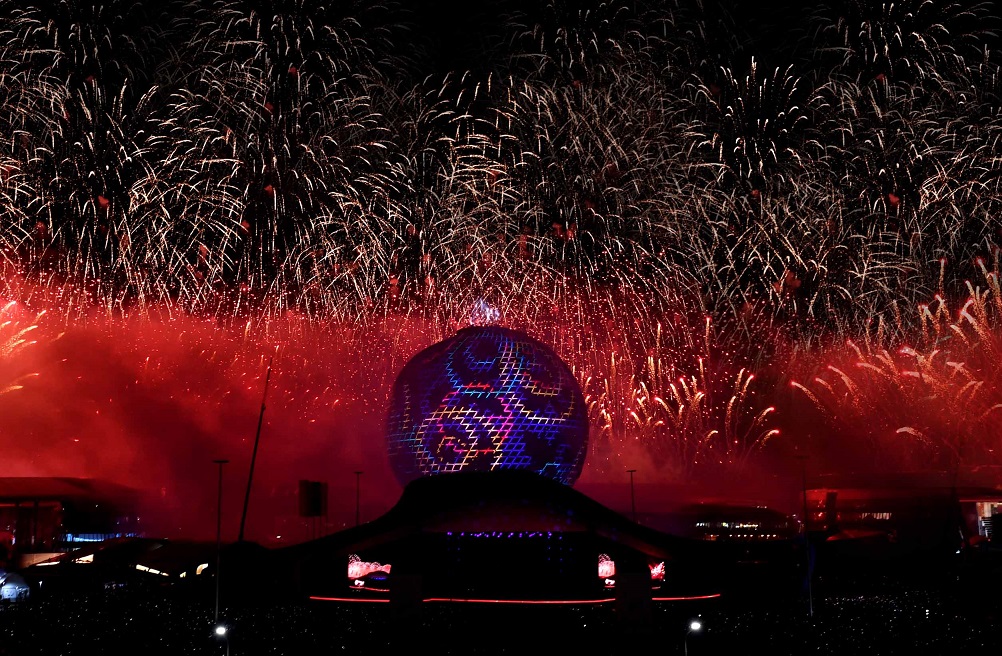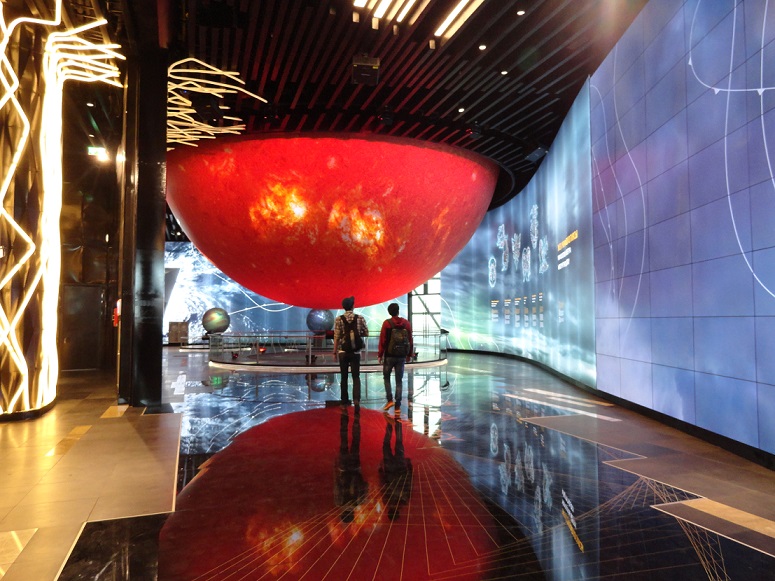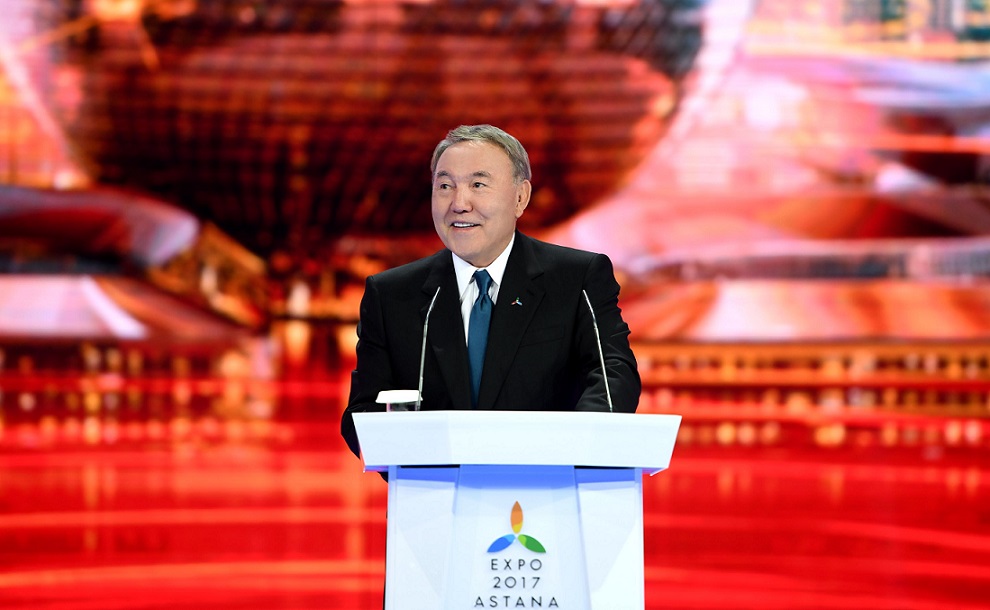With an extravagant show of fireworks and cultural festivities, Kazakhstan said goodbye earlier last week to the three-month-long world’s fair known as Expo 2017, held in the capital city of Astana from June 10 through September 10. Although the crowds have left, the central government is expecting the fair, which had been centered around the theme of global energy, to have a long-term impact.
“It has had a positive multiplier effect, and gave impetus to the further development of our country’s economy,” Kazakhstan’s President Nursultan Nazarbayev said on Sunday at the closing ceremony.
More than 100 countries and over 20 international organizations showcased achievements in “green,” or renewable, energy technologies. National pavilions included those from Russia, complete with a block of ice hauled in from the Arctic, and China’s which outsized all others except that of the host country. The Chinese proudly displayed new generation refrigerator that consumes about half the energy currently required to power today’s refrigerators, or only 0.48 kWh per day versus 0.96 KWh.

This year’s expo was not only a first for Kazakhstan and the Central Asia and Caspian regions; it was the first held in a former Soviet republic. In November 2012, Paris-based Bureau International des Expositions chose the country, which borders the northeastern shore of the Caspian Sea, to host the expo, outstripping the Belgian city of Liège.
Officials and businesses got to work right away, as 196 local companies were hired to design and build over 38 facilities to fill the 174 hectares (430 acres) of space allocated on the outskirts of the city, which included pavilions, exhibition halls and the necessary infrastructure to keep the facilities running. Roughly 50,000 local jobs were created as a result, according to Sergey Kuyanov, the head of Public Relations Department at Astana EXPO-2017.
“Some 140 local companies were recruited by the government and contractors, while 21,000 people were directly involved in the organization of the expo,” Kuyanov told Caspian News.
Now, after more than four years of preparation and three months of fanfare, construction workers and engineers face the task of having to dismantle some of the structures.
But not everything is going away. With a $128 billon-strong economy – the most successful in Central Asia – the government in Astana has big plans for some of the buildings and spaces used to host the expo. Several of the national pavilions, including the Kazakhstani pavilion, will be used to permanently house large-scale initiatives focusing on foreign capital and investment and alternative energy technologies.
“We will launch there the Financial Center Astana, the Center for the Development of Green Technologies and Investments, as well as a technology park for IT start-ups,” Anuar Zhainakov, a press officer from Kazakhstan’s Foreign Ministry, told Caspian News.
The Astana International Financial Center has already been authorized by the government to set up shop in now-former expo buildings and is being granted special legal and tax privileges. President Nazarbayev hopes to see it blossom as a center for investment capital flowing into the region, develop the country’s capital market and aid in asset and individual wealth management.

The financial center, expected to open its doors sometime next year, will also provide services for the trade markets of neighboring countries including Kyrgyzstan, Uzbekistan, Tajikistan, Mongolia and countries in the Caucasus. Once joining the AIFC, companies that import raw materials and materials for investment projects will be exempt from taxes for 50 years. Benefits also include special visa and currency regimes within the territory of the center.
The Kazakhstan Stock Exchange, currently based in the country’s former capital Almaty, will operate within AIFC, as well as the country’s National Fund and the Unified Accumulative Pension Fund. Representatives from the Nasdaq Stock Market and markets based out of London, Chicago and others in New York are reported to have been tapped by leaders in Astana to discuss the creation of high-tech exchange infrastructure, according to Kairat Kelimbetov, the Governor of the AIFC.
The Center for the Development of Green Technologies and Investments is expected to launch by the end of this year, according to Kazakhstan’s Energy Ministry. The center is a direct outgrowth the expo’s theme, “Future Energy,” and is being launched to promote global sustainable development through the support and promotion of “green” technologies. The World Bank, European Bank for Reconstruction and Development, the European Investment Bank and the Global Environment Facility are expected to back the project.
Sustainable urban development and the transition to green technologies and best practices in business will be focal points. The center is expected to bring together experts from the Caspian region including those in Azerbaijan, Turkmenistan, and Iran, as well as Uzbekistan, Kyrgyzstan, Tajikistan, Afghanistan, and Mongolia.
Entrepreneurs and “techies” are being given a boost, thanks to the IT start-ups park that will also go online by the end of 2017. The expo’s Commercial Pavilion will be home to Kazakhstani computer and other technology specialists, who will be provided with working and living spaces.

The expo’s focal point and central pavilion, belonging to the host country and known as Nur Alem (“the shining world”) in Kazakh, will now function as a museum, with exhibits on energy technologies showcased throughout the eight-storied structure that rises to 100 meters.
“The capital of Kazakhstan has been in the epicenter of global attention. Kazakhstan has strengthened its image as a safe and dynamically developing state in the Eurasian region,” Nazarbayev said at closing ceremony on September 10.







 Armenian sappers commenced on Monday mine-clearance operations in the territories adjacent to the Saint Mary Church in village of Voskepar (Armenia...
Armenian sappers commenced on Monday mine-clearance operations in the territories adjacent to the Saint Mary Church in village of Voskepar (Armenia...
 Russian Foreign Minister Sergei Lavrov has reasserted that Moscow has no intentions to stop the fighting in Ukraine, even if peace talks commence.
Russian Foreign Minister Sergei Lavrov has reasserted that Moscow has no intentions to stop the fighting in Ukraine, even if peace talks commence.
 Iran has refuted reports of alleged damage to Shimon Peres Negev Nuclear Research Centre located southeast of Dimona, Israel, during the recent air...
Iran has refuted reports of alleged damage to Shimon Peres Negev Nuclear Research Centre located southeast of Dimona, Israel, during the recent air...
 Iran’s Foreign Minister, Hossein Amir-Abdollahian, has labeled a foiled Israeli drone attack in certain parts of the country as a "failure" for Isr...
Iran’s Foreign Minister, Hossein Amir-Abdollahian, has labeled a foiled Israeli drone attack in certain parts of the country as a "failure" for Isr...



